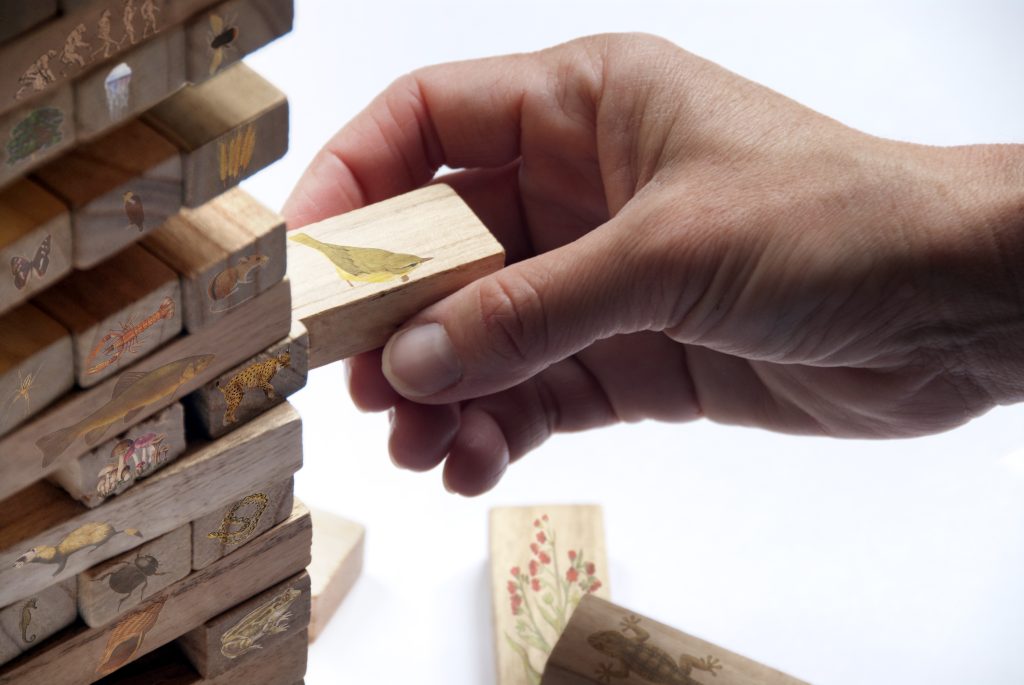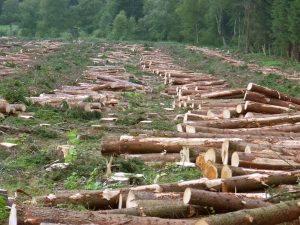1.2 Biodiversity Crisis
Despite the importance of biodiversity, the Earth is currently facing a biodiversity crisis. The biodiversity crisis refers to the significant and rapid decline in the variety of life on Earth, driven largely by human activities.
The World Wildlife Fund’s (WWF) Living Planet Report (2020) indicates that global wildlife populations have decreased by 68% since 1970. According to the International Union for Conservation of Nature IUCN (2024), over 44,000 species are currently threatened with extinction, including 41% of amphibians, 37% of sharks and rays, 36% of reef-building corals, 34% of conifers, 26% of mammals, and 12% of birds.
Jenga Analogy
As more and more species disappear, the intricate ecological networks become unstable. Imagine biodiversity as a Jenga tower. Each block represents a different species, ecosystem, or ecological process. In a well-balanced tower, every block supports the overall structure, contributing to its stability and integrity (Noseworthy, 2014).

When you play Jenga, removing one block might not immediately cause the tower to collapse. Similarly, the loss of a single species might not have an obvious or immediate impact on the ecosystem. However, as you continue to remove more blocks, the structure becomes increasingly unstable. Each block removed represents the extinction of a species or the degradation of an ecosystem, which weakens the overall system.
In the context of biodiversity, every species, no matter how small or seemingly insignificant, plays a role in maintaining the health and balance of its ecosystem. Pollinators like bees support plant reproduction, plants provide oxygen and food, predators keep prey populations in check, and decomposers recycle nutrients back into the soil. The loss of these species disrupts these critical interactions, just as removing key blocks destabilizes a Jenga tower.
As more species become endangered or extinct, the ecological “Jenga tower” grows weaker. Eventually, the loss of enough species can lead to the collapse of entire ecosystems, much like a Jenga tower toppling over. Right now, in the midst of the biodiversity crisis, our ecological Jenga tower is teetering. What’s causing the fragility?
Us.
Humans.
Causes of Biodiversity Decline
Many different human activities upset the natural balance of our ecosystems, but some are more damaging than others.
The human activities that are contributing to most of the biodiversity crisis include:
Habitat Destruction and Fragmentation

Habitat destruction is the leading cause of biodiversity loss. As natural landscapes are converted for agriculture, urban development, and industrial use, species lose their homes and the resources they need to survive. Fragmentation occurs when large habitats are divided into smaller, isolated patches, making it difficult for species to move, find mates, and access food (Berg et al., 2001).
The Canadian boreal forest, one of the largest intact forest ecosystems in the world, is being fragmented and destroyed by logging, mining, and oil extraction. This deforestation threatens species such as the woodland caribou, which depends on large areas of old-growth forest for their survival. Habitat fragmentation isolates caribou populations, making it difficult for them to find food and escape predators.
Climate Change
Climate change, driven by human activities like burning fossil fuels and deforestation, is altering temperature and precipitation patterns globally. These changes affect the habitats and life cycles of many species, pushing them to adapt, migrate, or face extinction.
The increasing temperatures associated with climate change are more drastic in Northern latitudes. Rising temperatures in the Canadian Arctic are causing sea ice to melt earlier in the spring and form later in the autumn. Polar bears rely on sea ice to hunt seals, their primary food source (Archer, 2024). As their hunting grounds shrink, polar bears are forced to travel longer distances and expend more energy, leading to decreased body condition, lower cub survival rates, and increased mortality.
Pollution

Pollution from industrial, agricultural, and urban sources severely impacts biodiversity. Pesticides and chemicals can kill wildlife outright or create reproductive problems that threaten the species’ survival. Eutrophication, caused by nutrient runoff from fertilizers, leads to dead zones in water bodies where oxygen levels are too low to support life. Plastic pollution, in particular, has become a pervasive threat. Plastic waste not only entangles marine animals, causing injury and death, but is also ingested by a wide range of species, from tiny plankton to large whales. Ingested plastics break down into microplastics. These microplastics are now found in virtually every part of the ocean, even in the most remote areas.
Mining generates more pollutants than any other industry in North America. The extraction of oil from the Alberta oil sands has significantly contributed to environmental pollution. Tailings ponds, which store the toxic by-products of this extraction process, have contaminated local water sources, which harm aquatic life. Air pollution from oil sands operations releases substances that can lead to acid rain, adversely affecting both terrestrial and aquatic ecosystems.
Overexploitation
Overexploitation involves harvesting species from the wild at rates faster than their populations can recover. This includes overfishing, hunting and logging. Overfishing has depleted many fish stocks, driving some species to the brink of extinction. The illegal wildlife trade targets animals like elephants, rhinos, and tigers for their ivory, horns, and skins, drastically reducing their populations.
The Atlantic cod fishery off the coast of Newfoundland and Labrador was once one of the world’s richest fisheries—however, decades of overfishing led to the collapse of the cod population in the early 1990s. Despite a moratorium on cod fishing, the population has struggled to recover due to ongoing fishing pressures and changes in the marine ecosystem.
Invasive Species

Invasive species are non-native organisms introduced to new environments, often through human activity. These species can outcompete, prey on, or bring diseases to native species, disrupting local ecosystems.
Zebra mussels, native to Eastern Europe, were introduced to the Great Lakes in the late 1980s via ballast water from ships (Fisheries and Oceans Canada, 2023). These invasive mussels reproduce rapidly, outcompeting native species for food and habitat. They filter out large amounts of plankton, which disrupts the aquatic food web and reduces populations of native mussel and fish species.
Going back to our Jenga analogy, the good news is that if we stop removing blocks – if we halt the destruction of habitats, mitigate climate change, reduce pollution, end overexploitation, and control invasive species then there is a good chance that the tower will remain standing. By protecting existing species and restoring damaged ecosystems, we can stabilize the Jenga Tower of biodiversity. This highlights the urgent need for proactive conservation efforts to maintain the delicate balance of our planet’s ecosystems.
Reflection
It’s important that we all understand our impact on biodiversity decline so that we can address these major causes of biodiversity decline.
Take a moment to think about your lifestyle. Are you part of the problem? What are some changes that you can make in your own life to help preserve biodiversity for future generations?
A Closer Look
Climate change is also disrupting crucial interactions between species.
Plants and animals have a particular phenology or timing of seasonal activities, such as flowering, breeding, migration, and hibernation. As global temperatures rise and weather patterns shift, many species are experiencing changes in the timing of life cycle events—phenological mismatch results when shifts lead to mismatched timing between species and their environments. Phenological mismatch can make it harder for species to get the resources they need to survive.
- Birds: Many bird species time their migration and breeding to coincide with peak food availability. Some migratory birds may arrive at their breeding grounds earlier due to warmer temperatures. This can lead to food shortages and reduced reproductive success if the insect populations they rely on for food have not yet peaked.
- Fish: Many fish species, like salmon, rely on temperature cues to time their spawning migrations. Warmer water temperatures can alter the timing of these migrations, affecting the synchronization with optimal river flow conditions for spawning and the availability of suitable habitats for their young.
- Pests: Longer growing seasons and warmer winters can lead to higher survival rates and extended activity periods for pests, such as bark beetles. This can result in more significant damage to forests and crops, as pest populations are no longer kept in check by cold winter temperatures.
- Pollinators: Insects like butterflies and bees may emerge earlier in the spring in response to warmer temperatures. This can affect their availability as pollinators for plants that have not adjusted their blooming times accordingly.
- Mammals: Some mammals, like bears, rely on temperature and food availability cues to enter and emerge from hibernation. Warmer winters can shorten hibernation periods, leading to increased energy expenditure and the need for more food, which may not be readily available.
“The biosphere: A complex and interconnected web of life” in the Ukrainian Journal of Ecology by H. Vardan is licensed under a Creative Commons Attribution 4.0 International License. Jenga Analogy – Third paragraph

